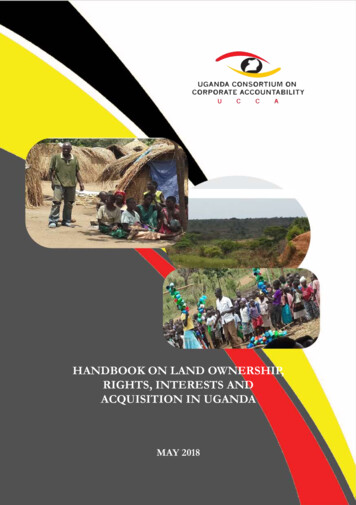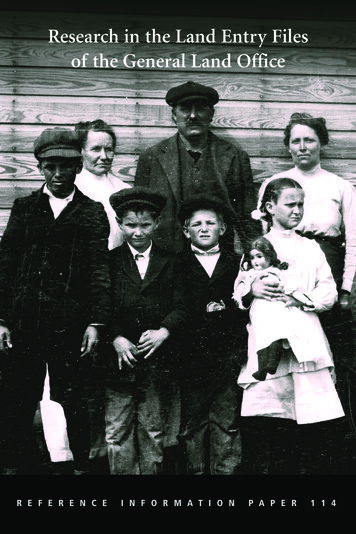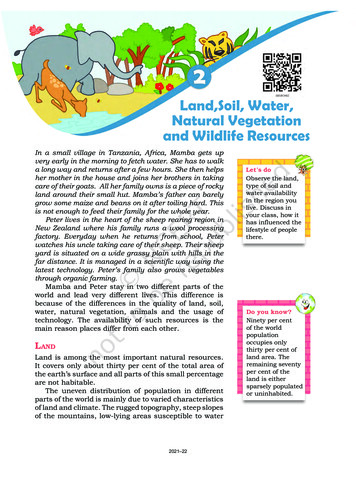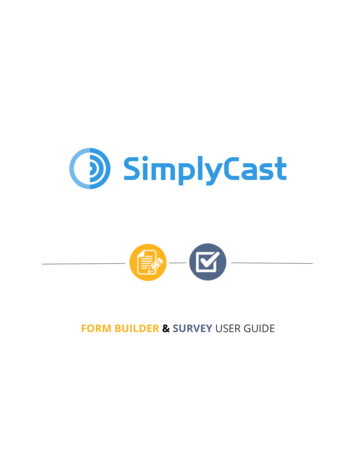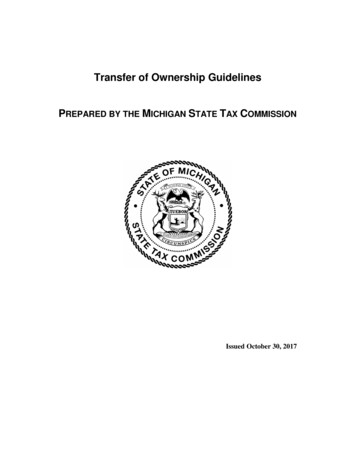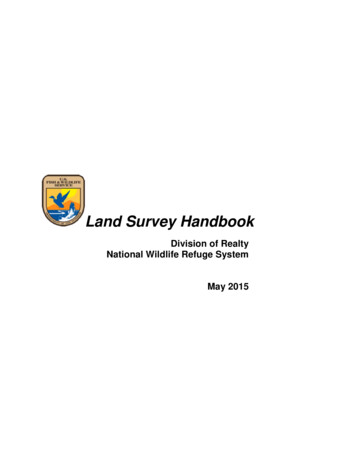
Transcription
Land Survey HandbookDivision of RealtyNational Wildlife Refuge SystemMay 2015
LAND SURVEY HANDBOOKChapter 1 - Introduction1.1 Purpose of the Handbook1.2 Objective of the Handbook1.3 Scope of the HandbookChapter 2 - Authority and History2.1 Authority and History Overview2.2 Federal Authority Cadastral Surveys2.3 State Authority Cadastral Surveys2.4 Authorities for Land Surveying2.5 History of the FWS Land Survey ProgramChapter 3 - Organization and Administration3.1 Organization and Administration3.2 DutiesA. Chief Land SurveyorB. Regional Land Surveyor3.3 Recruitment and Professional Development3.4 AdministrationA. Survey Funding SourcesB. Project Planning3.5 Boundary Management3.6 Cross Program Coordination3.7 Recordkeeping and Data Management3.8 Annual Reporting of Accomplishments3.9 Land Status MappingChapter 4 - Land Acquisition4.1 Land Acquisition4.2 The Land Acquisition Process4.3 Vendor SurveysChapter 5 Survey Tract Review5.1 Survey Tract Review5.2 Legal Descriptions5.3 Tract Acreage Determination5.4 Tract Numbering and Roman Numeral Tracts5.5 Evaluating Tract Access5.6 Evaluating EncumbrancesA. Title ExceptionsB. Encroachments5.7 Partial Acquisitions5.8 Field InspectionChapter 6 Cadastral Surveys6.1 Cadastral Surveys2
A. Surveys Authorized for Use by the ServiceB. Surveys Required by DOJ Title StandardsC. Surveys Required Prior to Land AcquisitionD. Surveys Required After Land Acquisition6.2 Steps of a cadastral surveyA. Determine if a Survey is NeededB. Request for SurveyC. Request ReceivedD. Project InstructionsE. Assignment InstructionsF. Additional ResearchG. Control SurveyH. Field SurveyI. MonumentationJ. Prepare Survey ReturnsK. Survey Review and Plat SigningL. Filing6.3 Access to Private LandsChapter 7 Boundary PostingChapter 8 Construction and Maintenance Surveys8.1 Construction and Maintenance Overview8.2 Roles and ResponsibilitiesA. Project ManagerB. Regional Land Surveyor8.3 Funding and Management of Construction and Maintenance ProjectsA. Deferred Maintenance ProjectsB. Construction ProjectsC. Advanced Project PlanningD. Current Project Scoping8.4 Specifications for Control and Topographic Surveys8.5 Construction Projects on Non-Service landsA. Partners for Fish and WildlifeB. National Fish Passage ProgramC. Roles and Responsibilities8.6 The Refuge Roads ProgramChapter 9 Surveys for Water Resources, Mapping, and Science9.1 OverviewA. DefinitionsB. Roles and Responsibilities9.2 Water Resources and Water Rights SurveyingA. The Water Resources Program3
B. Water RightsC. Acquiring and Managing State Appropriative Water RightsD. Land Surveyor’s Role in Water Resources and Water Rights9.3 Controlled Mapping9.4 Surveying for Scientific InvestigationsChapter 10 Contracting and Agreements10.1 Contracting Overview10.2 Roles and Responsibilities10.3 Contract ProcessA. Preliminary PlanningB. Prepare Statement of Work (SOW)C. Prepare Cost EstimateD. Submit Purchase RequestE. Contractor SelectionF. Fee NegotiationG. Contract Administration10.4 Contractor SelectionA. Evaluation CriteriaB. Statement of QualificationsC. SolicitationD. Contractor Evaluation10.5 Preparing the Contract PackageA. Types of ContractsB. Developing the Technical Specifications and Statement of WorkC. Dealing with Uncertainties10.6 Independent Government Estimate and Contractor’s Fee ProposalA. Cost EstimateB. Fee Proposal10.7 Contract AdministrationA. Duties of a Contracting Officers RepresentativeB. Pre-Work MeetingC. Contract ScheduleD. Pre-Monumentation Review10.8 Inter- and Intra-Agency AgreementsA. Inter-Agency AgreementsB. Intra-Agency AgreementsC. Overhead Charges and Service First AgreementsD. AuthoritiesE. Intra-Agency Agreement Process4
Chapter 1Introduction1.1 What is the purpose of the Land Survey Handbook? The Land Survey Handbook establishesprocedures and guidance on cadastral surveys and other land survey services required for themanagement, acquisition, and disposal of U.S. Fish and Wildlife (Service) lands. The guidance in thishandbook describes the general procedures for the most common types of work Service land surveyorsencounter throughout the year. Due to the nature of survey work and the many different possiblescenarios, the handbook does not provide procedures for all scenarios or land tenure found throughoutthe United States and its territories. The job of the Service land surveyor is to follow the generalguidelines in this handbook and adapt their survey situation to meet the intended outcome, while abidingby the applicable Federal and State laws and the Service policies and guidelines in Part 343, CadastralSurveys and Maps.The National Wildlife Refuge System (NWRS) survey team will update this handbook as needed aspolicies, professional practices, and technologies change.1.2 What are the objectives of this Land Survey Handbook? This handbook provides the proceduresand guidance to the Regional Land Surveyors (RLS) and staff to perform the Survey Tract Review,cadastral surveys, and other land survey services necessary to support the mission of the Service. Thehandbook also provides land surveyors an overall view of the types of work they must perform, thegeneral procedures they must follow, and the expectations the Service has for their work. It’s alsointended to serve as a training guide.1.3 What is the scope of the Land Survey Handbook? The Land Survey Handbook covers proceduresfor land surveys on Service lands. Service lands are any lands where the Service holds fee title, partialinterest, or is in the process of acquiring such an interest. Service land surveyors may also supportService programs on non-Service lands.
Chapter 2Authority and History2.1 Authority and History. Cadastral surveys for the Service are either authorized under Federal orState authority. Before a Service land surveyor begins any survey, he/she must determine what theauthority is for the survey. Some cadastral surveys can be conducted under either authority, but usuallyone is better than the other, and they should not be mixed. Sections 2.2 and 2.3 of this handbook provideguidance on when to use Federal or State authority, and if you can use either authority, whichever is best.The Federal authority for Service land surveys derives from two sources: the Migratory Bird ConservationAct, 16 U.S.C. 715 et seq., and 43 U.S.C. 2, Duties Concerning Public Lands. The Migratory BirdConservation Act gives the Secretary of the Interior authority to acquire or lease lands for migratorywaterfowl purposes and do all things and make all expenditures necessary to secure safe title. 43 U.S.C.2 provides that: “The Secretary of the Interior or such officer as he may designate shall perform allexecutive duties appertaining to the surveying and sale of the public lands of the United States.” TheSecretary has delegated authority to the Service (National Wildlife Refuge System - Division of Realty) toperform cadastral surveys and mapping through 142 DM 3.Land surveys conducted under State authority are subject to the laws of the State in which the land islocated. For a Service land surveyor to operate under State authority, he/she must have licensure in thatState to practice land surveying. Whether surveying private land under State or Federal authority, yoursurvey decisions are governed by State statute and common law regarding real property ownership.Because of this, we encourage surveying under State authority and will pay for the surveyor’sexaminations and licensing in all states in the surveyor’s Region where surveys are needed.2.2 Federal Authority Cadastral SurveysA. Cadastral surveys authorized under Federal authority:(1) Dependent resurveys of public domain lands withdrawn for a National Wildlife Refuge or Serviceadministration site, and(2) Cadastral surveys on acquired lands or lands that we plan to acquire, although we recommend usingState authority on acquired lands as State laws apply to private lands.B. Cadastral surveys not authorized under Federal authority:(1) Original cadastral surveys of the public domain lands, unless acting under authority of the Bureau ofLand Management (BLM) (see 757 DM 2, Surveying and Mapping), and(2) Cadastral surveys required for a U.S. patent (conveyance of public domain lands to private party),unless acting under authority of BLM (see 757 DM 2).2.3 State Authority Cadastral SurveysA. Cadastral surveys authorized under State authority:(1) Dependent resurveys of public domain lands withdrawn for Service administration,2
(2) Cadastral surveys of acquired lands or lands that we plan to acquire, and(3) Subdivision of acquired lands.B. Cadastral surveys not authorized under State authority:(1) Original cadastral surveys of public domain lands, and(2) Surveys required for a U.S. patent on public domain lands.C. The advantages of using State authority for land surveys are:(1) Most states have recordation laws, so the survey plats/maps produced are officially recorded/filed in apublic record system and are easier for other licensed land surveyors and the public to obtain, and(2) State authority surveys may be required as a part of a land division application, which is often requiredfor partial acquisitions.2.4 Authorities for Land SurveyingA. 43 U.S.C. 2. Verbatim: “The Secretary of the Interior or such officer as he may designate shall performall executive duties appertaining to the surveying and sale of the public lands of the United States, or inanywise respecting such public lands, and, also, such as relate to private claims of land, and the issuingof patents for all grants of land under the authority of the Government.”B. 43 U.S.C. 52. Verbatim: “The Secretary of the Interior or such officer as he may designate shallengage a sufficient number of skillful surveyors as his deputies, to whom he is authorized to administerthe necessary oaths upon their appointments. He shall have authority to frame regulations for theirdirection, not inconsistent with law or the instructions of the Bureau of Land Management, and to removethem for negligence or misconduct in office.”C. The Migratory Bird Conservation Act (16 U.S.C. 715 – 715r) provides the funding authority for us toacquire or lease lands for migratory waterfowl purposes and do all things and make all expendituresnecessary to secure safe title.D. The Presidential Reorganization Plan No. II of 1939 (53 Stat. 1431) transferred the Bureau ofBiological Survey and its functions from the Department of Agriculture to the Department of the Interior.E. The Presidential Reorganization Plan No. III of 1940 (54 Stat. 231) consolidated the Bureau ofFisheries and the Bureau of Biological Survey and their functions into one agency within the Departmentof the Interior—the U.S. Fish and Wildlife Service.F. The Migratory Bird Hunting and Conservation Stamp Act (16 U.S.C. 718-718h) provided the fundingauthority for us to acquire lands for conservation purposes.E. The National Wildlife Refuge System Administration Act (16 U.S.C. 668dd – 668ee) providesguidelines and directives for administration and management of all areas in the National Wildlife RefugeSystem (NWRS).G. The Brooks Act (Pub. L. 92-582, 86 Stat. 1278), which amended the Federal Property andAdministrative Services Act of 1949, establishes Federal policy concerning the selection of firms andindividuals to perform architectural, engineering, and related services for the Federal Government.3
H. 757 DM 2, Surveying and Mapping, and the Manual of Surveying Instructions (2009 edition) providerequirements and instructions for Departmental cadastral surveying.I. 142 DM 3, U.S. Fish and Wildlife Service, establishes that the Service’s Division of Realty in theNational Wildlife Refuge System provides central coordination and direction of all activities relating to theacquisition and disposition of lands and interests for the NWRS and the National Fish Hatchery System.“The Division performs . cadastral surveys and mapping, processes land and mineral applications, andperforms other actions associated with land acquisition ”J. 600 DM 5, Standards of Boundary Evidence provides managers of Federal interest assets with themeans to effectively apply boundary evidence to protect assets.K. State and territory land survey licensure laws and standards provide the requirements and instructionsfor conducting surveys on private lands under State authority.2.5 History of the Service’s Land Survey ProgramThe Service’s Realty program was initially created to acquire lands for the preservation of migratory birdhabitat, as authorized by the Migratory Bird Conservation Act of 1929. At that time, the NWRS wasadministered by the Bureau of Biological Survey (BBS) in the Department of Agriculture. The landsurveyors and cartographers in the Surveys and Maps Section, Division of Land Acquisition, worked withRealty Specialists and Appraisers to establish over 140 National Wildlife Refuges between 1929 and1941.The Reorganization Plan II of 1939 transferred the BBS and its functions to the Department of the Interior,and in 1940 the BBS and the Department of Fisheries were combined to form the U.S. Fish and WildlifeService. The land surveyors and cartographers were moved to the Division of Management, Branch ofEngineering, in about 1950, and that part of the Service was renamed the Bureau of Sport Fisheries andWildlife in 1956. The survey program was finally moved back to the Division of Realty in the RefugesProgram in about 1974, at the same time that the Bureau of Sport Fisheries and Wildlife was re-namedthe U.S. Fish and Wildlife Service.The oldest known Manual documenting Service Cadastral Survey and Mapping procedures was theManual of the Division of Land Acquisition, produced by the BBS in about 1936. Developed by ArthurReimer, Chief of the Surveys and Maps Section, this Manual described in detail how to record and indexfield notes, the types of monuments to set, mapping standards, how to hire temporary employees, andhow to set up camp. Section 6473 of the Manual explained the tract numbering convention, whichremains essentially unchanged today. The Manual was distributed in a loose-leaf binder so that pagescould be replaced as needed, and was in use until at least 1950. It was later included in the EngineeringHandbook of the Bureau of Sport Fisheries and Wildlife, and finally in the U.S. Fish and Wildlife ServiceRealty Manual, 1983. The Land Survey Manual was first published online (343 FW 1 and 343 FW 2) in1995, and was revised concurrently with the creation of this Handbook in 2014.4
Chapter 3Organization and Administration3.1 Organization and Administration. The Service land surveyors consist of a Chief Land Surveyorlocated in the Headquarters office, Regional Land Surveyors (RLS), and staff land surveyors located ineach Region. The land survey program is organized in the Division of Realty under the Chief of theNational Wildlife Refuge System (NWRS). The Chief Land Surveyor reports to the Chief, Division ofRealty. In each Region, the RLS and staff land surveyors are organized within the Division of Realty forthat Region. The RLS reports to the Regional Realty Officer, and in most Regions the staff land surveyorsreport to the RLS.3.2 Duties.A. Chief Land Surveyor. The Chief Land Surveyor oversees all land survey activities relevant to theDivision of Realty land acquisition program and boundary management on Service lands. He or she isresponsible for national policy interpretation and Servicewide policy formulation, managerial leadershipand technical guidance, program implementation and evaluation, and internal and external coordinationnecessary for the successful management of the survey program. As needed, he or she issues technicaland procedural program guidance to ensure adequate technical support and proficiency, provides thefinal interpretation for the Service Manual regarding cadastral surveys, and assists the Office of theSolicitor and the Department of Justice in preparing the technical and legal portions of litigation involvingcadastral surveys on Service lands.The Chief Land Surveyor also acts as the consulting specialist for the cadastral survey program onrelated activities between the Service and other Federal, State, tribal, and private entities, and representsthe Service on the Interagency Cadastral Coordination Council (ICCC).B. Regional Land Surveyor (RLS). The RLS is responsible for all cadastral surveys of Service landswithin his/her Region, and for the development and administration of the Region's land survey program.He/she is responsible for Regional policy interpretation, managerial leadership and technical guidance,program implementation and evaluation, and internal and external coordination necessary for thesuccessful management of the Region’s survey program. This includes supporting land acquisitions,realty management, water rights acquisition, construction, and boundary management. He/she plans theworkload and program budget, estimates survey project time and cost, and performs Survey TractReviews, boundary surveys, and other land survey services. Other duties include Certified Department ofthe Interior Land Surveyor (CILS) responsibilities, acting as the Contracting Officer’s Representative(COR), and representing the Region and the Service as an expert witness on land survey matters inFederal court, the Federal Civilian Board of Contract Appeals, and the Interior Board of Land Appeals.The Chief Land Surveyor may ask the RLS to assist on national committees with responsibility fordefining standards, techniques, and methods for complex technical and scientific land surveying issues.3.3 Recruitment and Professional Development. The Service encourages professional advancementand the pursuit of excellence for the surveying staff, which can be enhanced through professionalaffiliations. Membership in national and local societies is not required, but is highly recommended.Professional societies are an excellent source of information for legal and technical issues in thesurveying and mapping disciplines. In addition, they provide a forum for exchange of ideas, concepts, andtechniques. We encourage all survey and mapping personnel to attend at least one annual professionalsociety meeting, as well as to present papers as part of their attendance.3.4 Administration. The RLS, in coordination with the Regional Realty Officer and other program leads,will develop an Annual Work Plan (AWP) for the next year’s planned projects. Because of the nature ofthe acquisition process and shifting priorities, knowing exactly which projects will be requested during thefollowing year is impossible. Therefore, the RLS must make a prediction about which projects will move5
forward and develop a project plan, while remaining flexible so he/she can shift work as projects arecancelled or added or priorities change. To predict the next year’s projects and ensure orderly planningand budgeting, the RLS should meet with the program leads that typically require survey services todetermine their priority projects. These meetings should take place well in advance of submitting thePreliminary Target Allocation (PTA) to Headquarters. Early planning helps us to fund and schedulesurveys for completion in a timely manner and meet the needs of the requesting programs. We chargethe costs of surveys to the requesting program/division unless previous arrangements are made toaccumulate costs in a clearing account for reimbursement, or they are included in the current AWPbudget.A. Funding for land survey services typically comes from one of three sources: Migratory BirdConservation Fund (MBCF), Land and Water Conservation Fund (LWCF), or appropriated funds. TheRLS must coordinate with the Realty Specialists to determine the funding source(s) for a given project.The RLS then develops a time and cost estimate for those projects planned for the next year. Theestimates are provided to the Realty Officer in time for inclusion in the PTA, which is usually in the monthof May for next year’s budget. They eventually make their way into the AWP. The following table showsthe funding sources for each type of project.AppropriatedMBCFLWCFSurvey Tract ReviewAcquisition SurveyBoundary ance**Contract126112611262126213211321Small WetlandsAcquistionProgram(SWAP)AdministrationSWAP 2842284228451*1261* These funds may only be used if a survey of the tract was not completed at the time of acquisition.** Includes surveys required for construction and maintenance, including fencing.6
B. The RLS determines the most efficient or responsive method of completing the survey depending onits type, timeframe, location, and scope. Depending on the situation, the survey may be conducted by:(1) In-house staff surveyors,(2) Contractors with a private survey firm, or(3) Another agency through an intra- or inter-agency agreement.3.5 Boundary Management. Boundary management is the process of systematically evaluating,surveying, and marking high-priority boundaries; maintaining boundary infrastructure (survey monuments,posts, fences, etc.); and identifying and resolving encroachments and title claims. The goal of boundarymanagement is to provide the field station manager with the visible and legally correct boundaries neededto both manage their resources and protect the property rights of the Service and adjoining landowners.A. Boundary management is a responsibility the RLS shares with the field station staff and other Serviceemployees. The components of boundary management are as follows:1. Inventorying the existing boundary conditions. This is the responsibility of the RLS and includescompiling and indexing survey and corner records and boundary posting status, and putting them in aform so they can be retrieved and analyzed easily.2. Maintaining and protecting boundary posts and corner monuments. The field station manager isresponsible for monitoring the condition of the station boundaries. Field station staff should walk theboundary lines on a regular basis to determine the condition of the boundary. They should send a briefreport to the RLS regarding the date of the inspection and the condition of the posts and monuments.B. A ‘Boundary Management Plan’ can be very useful for field station managers to identify issues and fordirecting funding to the highest-priority projects. The plan should include an inventory of survey needs inpriority order and a dated cost estimate.C. The priorities for each field station are rolled up into a Regional survey priority list, which may bemaintained by the RLS or the Refuge/Hatchery supervisors, depending on Regional policy. The list isused both for developing annual work plans and to take advantage of funding opportunities.3.6 Cross Program Coordination.While most survey work will be in support of the Refuge land acquisition and boundary managementprograms, the RLS must also be prepared to provide support to the many other Service programs thatuse or generate land survey information. In addition to the Realty program staff and field stationmanagers, the RLS should become acquainted with the following program personnel:PersonRefuge Facilities/AssetCoordinatorRoleMaintains the 5-year RefugeDeferred Maintenance andConstruction plans.Role/ InteractionProvides cost estimates, especially ofrequired cadastral surveys. See Chapter 8.Hatcheries Facilities/Asset CoordinatorMaintains the 5-yearHatchery DeferredMaintenance andConstruction plans.Provides costs estimates, especially ofrequired cadastral surveys. See Chapter 8.7
PersonDivision of Engineering(DEN), RegionalEngineer and StaffRoleServes as Project Managerfor non-exempt and otherconstruction/maintenanceprojects, including themanagement of the DamSafety Program.Manages the Refuge roadsand transportation program.Role/ InteractionConducts or contracts for cadastral surveys.Conducts, contracts, or provides technicalstandards for design surveys. Researchesland ownership and consults on surveyissues. See Chapter 8.Refuge Inventory &Monitoring LeadManages and fundscontrolled mapping andother projects using surveyinstruments.Provides survey technical standards orcarries out control and evaluation surveys.Receives control and topographic data.Provides training and support for use ofsurvey grade instruments. See Chapter 9.Regional Water RightsManagerAcquires and manageswater rights for Refuges,Hatcheries, and otherprograms.Provides support, technical assistance, orprofessional services for measuring waterand acquiring State water rights. SeeChapter 9.Program Leads for Partners for Fish &Wildlife National FishPassage Program Coastal ProgramAdminister partnershipprograms that fund habitatimprovement, mostly onnon-Service lands.Provide technical standards, technicalsupport and training, and control information.See Chapter 8.Refuge RoadsCoordinatorProvides boundary and control data andreceives control and topographic data fromroad projects. See Chapter 8.3.7 Recordkeeping and Data ManagementA. Records of Federal Authority Surveys. As part of our Federal survey authority, the Service isresponsible for preserving the field notes, plats, and associated documents that form the official record ofour surveys, and for providing copies of this information to the public. Even among the land surveycommunity, it is not well known that the Service maintains a set of official survey records, and there havebeen needless mistakes and boundary conflicts on the part of private and other Federal land surveyorswho did not have access to Service survey information. The RLS’s responsibilities in regard to Servicecadastral survey records are as follows:1. Preserve original plats, field notes, and other information documenting the survey decisions aspermanent Federal records.2. File a copy of all Federal authority surveys with the local county or other recording office, and also inany State or local survey records databases. Note: not all State, county, or local governments recordFederal records. If they don’t, it’s important to maintain a duplicate record of the survey in a secure anddifferent location from that of the original document(s).3. Create a filing system so that members of the public, including other land surveyors, may have easyaccess to the survey records. Ideally, staff other than land surveyors should be able to locate the correctinformation and provide it to the public.8
B. Other Survey Records. As with Federal authority surveys, the records supporting State authoritysurveys must be preserved and provided to the public, whether carried out by Service employees orcontractors.1. A duplicate mylar copy of the recorded survey plat, the original field notes, and reports,correspondence, calculations, and other information sufficient to document the survey decisions shouldbe maintained in a permanent file.2. All permanent records should be scanned for security and for easy transmission to the public andcustomers.3.8 Annual Reporting of Accomplishments. The RLS compiles annual reports at the end of each fiscalyear for their Region’s survey accomplishments. The reports are used to showcase our accomplishments,determine efficiencies and inefficiencies, and evaluate future year budget needs. The RLS must submitthe report to the Chief Land Surveyor within 20 days of the end of the fiscal year, and it must contain:A. Cadastral Surveys (Boundary)(1) Number of miles of boundary survey completed on new boundaries by:(a) In-house survey crews,(b) Contract and vendor surveys, and(c) Other Federal agencies.(2) Number of miles of boundary surveys completed for boundary maintenance (existing boundaries) by:(a) In-house survey crews,(b) Contract and vendor surveys, and(c) Other Federal agencies.(3) Number of monuments set by:(a) In-house survey crews,(b) Contract and vendor surveys, and(c) Other Federal agencies.B. Survey Tract Review:(a) Number of Survey Tract Review requests received, and(b) Number of Survey Tract Review reports completed.C. Boundary Posting:(a) Number of miles of new boundary posted,(b) Number of miles of existing boundary posted, and(c) Number of posts set.3.9 Land Status Mapping.A. As the base layer of the Service GIS, the accuracy of the cadastral geodatabase is critical. It isbecoming more so as tools such as Google Earth allow display of boundaries at a very large scale,overlaid with high-resolution aerial images.9
B. Service cartographers and geographers create and maintain our cadastral geodatabase, which linksthe spatial location of Service-owned lands with the tabular land ownership data housed in the LandRecord System. Where surveyed tract locations are not available, it is based on the best available spatialdata, and is reviewed and approved for spatial accuracy by the RLS before it’s finalized. In Regionswhere the cartographers are not supervised directly by the RLS, the cartographers and RLS need to workas a team to build and maintain the Regional boundaries.10
Chapter 4Land Acquisition4.1 Land Acquisition. A primary function of land surveyors in the Service is to support our acquisition oflands. Fish and Wildlife surveyors play a key role in land acquisition, and must be familiar with all aspectsof the process. Training for land acquisition comes from the Realty Academy and Realty Service Manualchapters, but the role of the surveyor is covered here.This chapter gives a brief overview of the way we acquire land, and the role the land surveyor plays in theprocess.4.2 The Land Acquisition Process.The process of acquiring land for the United States of America is strictly governed by law
2.4 Authorities for Land Surveying 2.5 History of the FWS Land Survey Program Chapter 3 - Organization and Administration 3.1 Organization and Administration 3.2 Duties A. Chief Land Surveyor B. Regional Land Surveyor 3.3 Recruitment and Professional Development 3.4 Administration A. Su

